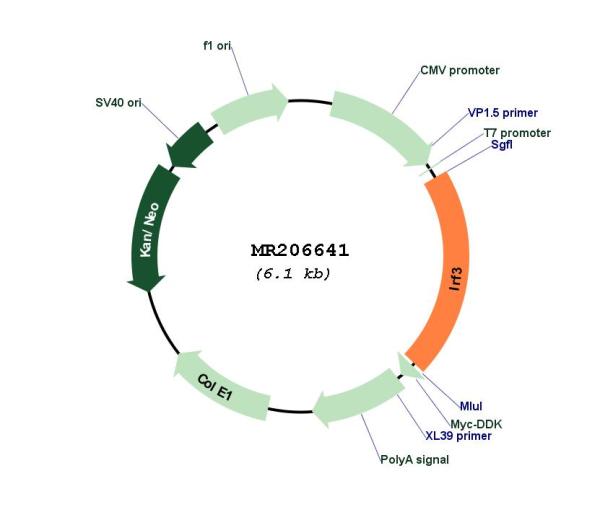Irf3 (NM_016849) Mouse Tagged ORF Clone
CAT#: MR206641
- TrueORF®
Irf3 (Myc-DDK-tagged) - Mouse interferon regulatory factor 3 (Irf3)
ORF Plasmid: tGFP
Lentiviral Particles: DDK w/ Puro mGFP w/ Puro
"NM_016849" in other vectors (4)
Interest in protein/lysate? Submit request here!
USD 198.00
Specifications
| Product Data | |
| Type | Mouse Tagged ORF Clone |
| Tag | Myc-DDK |
| Symbol | Irf3 |
| Synonyms | C920001K05Rik; IRF-3 |
| Vector | pCMV6-Entry |
| E. coli Selection | Kanamycin (25 ug/mL) |
| Mammalian Cell Selection | Neomycin |
| Sequence Data |
>MR206641 representing NM_016849
Red=Cloning site Blue=ORF Green=Tags(s) TTTTGTAATACGACTCACTATAGGGCGGCCGGGAATTCGTCGACTGGATCCGGTACCGAGGAGATCTGCC GCCGCGATCGCC ATGGAAACCCCGAAACCGCGGATTTTGCCCTGGCTGGTGTCACAGCTGGACCTGGGGCAGCTGGAAGGCG TGGCCTGGCTGGACGAGAGCCGAACGAGGTTCAGGATCCCGTGGAAGCATGGCCTACGGCAGGACGCACA GATGGCTGACTTTGGCATCTTCCAGGCCTGGGCAGAAGCCAGTGGTGCCTACACCCCGGGGAAGGATAAG CCGGACGTGTCAACCTGGAAGAGGAATTTCCGGTCAGCCCTGAACCGGAAAGAAGTGTTGCGGTTAGCTG CTGACAATAGCAAGGACCCTTATGACCCTCATAAAGTGTATGAGTTTGTGACTCCAGGGGCGCGGGACTT CGTACATCTGGGTGCCTCTCCTGACACCAATGGCAAAAGCAGCCTGCCTCACTCCCAGGAAAACCTACCG AAGTTATTTGATGGCCTGATCTTGGGGCCCCTCAAAGATGAGGGGTCCTCAGATCTGGCTATTGTTTCTG ATCCTTCTCAACAACTGCCAAGCCCCAATGTGAACAACTTCCTAAACCCTGCACCCCAAGAAAATCCACT GAAGCAGCTGCTAGCTGAGGAACAATGGGAGTTCGAGGTGACCGCCTTCTACCGAGGCCGCCAGGTCTTC CAGCAGACACTCTTTTGCCCGGGGGGCCTGCGGCTGGTGGGCAGCACAGCTGACATGACACTGCCCTGGC AGCCAGTCACCCTGCCCGATCCTGAGGGGTTTCTGACGGACAAGCTTGTGAAGGAGTACGTGGGGCAGGT GCTCAAAGGGCTGGGCAATGGGCTGGCACTGTGGCAGGCTGGGCAGTGCCTCTGGGCCCAGCGCCTAGGC CACTCCCACGCCTTCTGGGCTCTGGGGGAGGAGCTGCTTCCAGACAGTGGGCGAGGGCCTGATGGAGAGG TCCACAAGGACAAGGACGGAGCCGTGTTCGACCTCAGGCCCTTCGTGGCAGATCTGATTGCCTTCATGGA AGGAAGTGGACACTCCCCACGCTACACTCTGTGGTTCTGCATGGGGGAAATGTGGCCCCAGGACCAGCCA TGGGTCAAGAGGCTTGTGATGGTCAAGGTTGTTCCTACATGTCTTAAGGAGCTGTTAGAGATGGCCCGGG AAGGGGGAGCCTCTTCACTGAAAACCGTGGACTTGCACATCTCCAACAGCCAGCCTATCTCCCTTACCTC TGACCAGTACAAGGCCTACCTCCAGGACTTGGTGGAGGACATGGACTTCCAGGCCACTGGAAATATC ACGCGTACGCGGCCGCTCGAGCAGAAACTCATCTCAGAAGAGGATCTGGCAGCAAATGATATCCTGGATT ACAAGGATGACGACGATAAGGTTTAA >MR206641 representing NM_016849
Red=Cloning site Green=Tags(s) METPKPRILPWLVSQLDLGQLEGVAWLDESRTRFRIPWKHGLRQDAQMADFGIFQAWAEASGAYTPGKDK PDVSTWKRNFRSALNRKEVLRLAADNSKDPYDPHKVYEFVTPGARDFVHLGASPDTNGKSSLPHSQENLP KLFDGLILGPLKDEGSSDLAIVSDPSQQLPSPNVNNFLNPAPQENPLKQLLAEEQWEFEVTAFYRGRQVF QQTLFCPGGLRLVGSTADMTLPWQPVTLPDPEGFLTDKLVKEYVGQVLKGLGNGLALWQAGQCLWAQRLG HSHAFWALGEELLPDSGRGPDGEVHKDKDGAVFDLRPFVADLIAFMEGSGHSPRYTLWFCMGEMWPQDQP WVKRLVMVKVVPTCLKELLEMAREGGASSLKTVDLHISNSQPISLTSDQYKAYLQDLVEDMDFQATGNI TRTRPLEQKLISEEDLAANDILDYKDDDDKV |
| Restriction Sites |
SgfI-MluI
Cloning Scheme for this gene
Plasmid Map

|
| ACCN | NM_016849 |
| ORF Size | 1257 bp |
| OTI Disclaimer | Due to the inherent nature of this plasmid, standard methods to replicate additional amounts of DNA in E. coli are highly likely to result in mutations and/or rearrangements. Therefore, OriGene does not guarantee the capability to replicate this plasmid DNA. Additional amounts of DNA can be purchased from OriGene with batch-specific, full-sequence verification at a reduced cost. Please contact our customer care team at custsupport@origene.com or by calling 301.340.3188 option 3 for pricing and delivery. The molecular sequence of this clone aligns with the gene accession number as a point of reference only. However, individual transcript sequences of the same gene can differ through naturally occurring variations (e.g. polymorphisms), each with its own valid existence. This clone is substantially in agreement with the reference, but a complete review of all prevailing variants is recommended prior to use. More info |
| OTI Annotation | This clone was engineered to express the complete ORF with an expression tag. Expression varies depending on the nature of the gene. |
| Product Components | The ORF clone is ion-exchange column purified and shipped in a 2D barcoded Matrix tube containing 10ug of transfection-ready, dried plasmid DNA (reconstitute with 100 ul of water). |
| Reconstitution | 1. Centrifuge at 5,000xg for 5min. 2. Carefully open the tube and add 100ul of sterile water to dissolve the DNA. 3. Close the tube and incubate for 10 minutes at room temperature. 4. Briefly vortex the tube and then do a quick spin (less than 5000xg) to concentrate the liquid at the bottom. 5. Store the suspended plasmid at -20°C. The DNA is stable for at least one year from date of shipping when stored at -20°C. |
| Reference Data | |
| RefSeq | NM_016849.4 |
| RefSeq Size | 2041 bp |
| RefSeq ORF | 1260 bp |
| Locus ID | 54131 |
| UniProt ID | P70671 |
| Cytogenetics | 7 B3 |
| MW | 47.3 kDa |
| Gene Summary | Key transcriptional regulator of type I interferon (IFN)-dependent immune responses which plays a critical role in the innate immune response against DNA and RNA viruses (PubMed:15800576). Regulates the transcription of type I IFN genes (IFN-alpha and IFN-beta) and IFN-stimulated genes (ISG) by binding to an interferon-stimulated response element (ISRE) in their promoters (PubMed:15800576). Acts as a more potent activator of the IFN-beta (IFNB) gene than the IFN-alpha (IFNA) gene and plays a critical role in both the early and late phases of the IFNA/B gene induction (PubMed:16846591, PubMed:16979567, PubMed:20049431). Found in an inactive form in the cytoplasm of uninfected cells and following viral infection, double-stranded RNA (dsRNA), or toll-like receptor (TLR) signaling, is phosphorylated by IKBKE and TBK1 kinases (PubMed:16846591, PubMed:16979567, PubMed:20049431). This induces a conformational change, leading to its dimerization and nuclear localization and association with CREB binding protein (CREBBP) to form dsRNA-activated factor 1 (DRAF1), a complex which activates the transcription of the type I IFN and ISG genes (PubMed:16846591, PubMed:16979567, PubMed:20049431). Can activate distinct gene expression programs in macrophages and can induce significant apoptosis in primary macrophages (PubMed:16846591, PubMed:16979567, PubMed:20049431).[UniProtKB/Swiss-Prot Function] |
Documents
| Product Manuals |
| FAQs |
| SDS |
Resources
Other Versions
| SKU | Description | Size | Price |
|---|---|---|---|
| MC207502 | Irf3 (untagged) - Mouse interferon regulatory factor 3 (Irf3), (10ug) |
USD 686.00 |
|
| MG206641 | Irf3 (tGFP-tagged) - Mouse interferon regulatory factor 3 (Irf3) |
USD 886.00 |
|
| MR206641L3 | Lenti ORF clone of Irf3 (Myc-DDK-tagged) - Mouse interferon regulatory factor 3 (Irf3) |
USD 986.00 |
|
| MR206641L4 | Lenti ORF clone of Irf3 (mGFP-tagged) - Mouse interferon regulatory factor 3 (Irf3) |
USD 986.00 |
{0} Product Review(s)
Be the first one to submit a review






























































































































































































































































 Germany
Germany
 Japan
Japan
 United Kingdom
United Kingdom
 China
China


